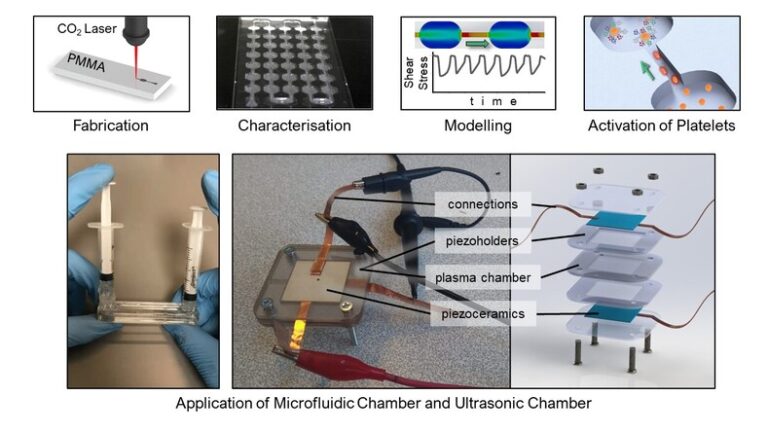Platelet-Rich Plasma (PRP) treatment, containing separated and concentrated platelets in blood plasma, is an autologous therapy and can be used by tissue injection in a range of fields, such as orthopaedic surgery, dentistry, sports medicine, aesthetic and plastic surgery. The healing and tissue regeneration ability of PRP has been attributed to the growth factors in alpha granules which are released by chemical and/or mechanical stimulation. This study aims to develop an easy-to-use biomedical device for mechanical activation of PRP to avoid the risks of side effects from chemicals.
We tested two mechanical forces for activation, shear stress and ultrasonication. The microfluidic chips were designed to create shear stress between 50 – 100 dyne/cm2. The dimensions of noded and pillared microfluidic chips were determined by using flow simulation. Alternatively, ultrasonication chamber is a device designed to apply ultrasound waves at frequencies of 0.55 and 1.10 MHz with a power of 5 and 10 V. The system utilizes two piezoceramic electrodes, one for the generation of ultrasonic waves and the other for validation. All devices were fabricated from the PMMA layer by the CO2 laser ablation and cutting methods.
After 3-minute stimulation, platelets were fluorescently labelled with P-Selectin (activated platelet marker) and CD61 (platelet marker) receptors and analyzed by flow cytometry. The activation percentage rate was found by determining the number of activated platelets in the total platelet population. While the activation rate in the positive control study with the chemical activators, thrombin and calcium, was 95.8%, the platelet activation rate was 72.7% in the 8-node microfluidic chip and 32.4% in the ultrasonication device. Obtaining different PRP activation level with these chips might be the pioneering studies for the different therapeutic applications. In other words, desired activation level for the specific treatment can be controlled by chip design.

